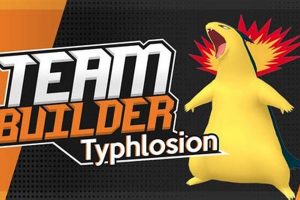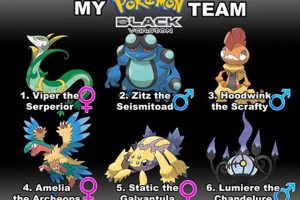Selecting a team in Pokmon GO occurs at Trainer Level 5 and involves choosing between Team Mystic (blue), Team Valor (red), or Team Instinct (yellow). This decision is a permanent selection that influences various aspects of the game, such as Gym control and participation in Team GO Rocket battles.
The chosen team determines a player’s allegiance and impacts social interactions within the game. While gameplay mechanics are largely unaffected, shared team affiliation creates camaraderie and competition among players. Historically, the team selection process has remained unchanged since the game’s initial launch, emphasizing its role as a core element of the Pokmon GO experience.
The subsequent sections will explore the individual characteristics of each team, offering guidance on factors to consider when making this pivotal in-game choice and helping players understand how their decision affects their overall gameplay experience.
Guidance on Team Selection in Pokémon GO
This section provides insights and considerations to aid in the selection of a Pokémon GO team, ensuring an informed decision aligned with individual gameplay preferences.
Tip 1: Consider Local Team Dominance: Observe the prevalence of each team within the local gaming community. Joining the dominant team may facilitate Gym control and raid participation; however, selecting a less popular team may present opportunities for unique competitive advantages.
Tip 2: Evaluate Leadership Philosophy: Each team is associated with a distinct philosophy espoused by its leader. Team Mystic values calm analysis, Team Valor emphasizes strength, and Team Instinct prioritizes intuition. Aligning with the philosophy that resonates most can enhance the gaming experience.
Tip 3: Assess Social Preferences: Determine the level of social interaction desired. Teammates often collaborate on raids and Gym defenses. Selecting a team with active local players can foster a more engaging social dynamic.
Tip 4: Understand Gym Control Dynamics: While any team can control Gyms, the distribution of Gym control within a region can influence gameplay. Joining a team that frequently battles for Gym control can provide more opportunities for Pokécoins and rewards.
Tip 5: Prioritize Personal Preference: Ultimately, the team selection should be based on personal enjoyment. The chosen team represents the player’s allegiance within the game; therefore, selecting the team that appeals most aesthetically or philosophically is crucial.
Tip 6: Research Team Strengths and Weaknesses: Certain events or in-game challenges may favor specific team compositions or strategies. Researching the strengths and weaknesses of each team can inform a more strategic decision.
By carefully considering these factors, a player can make a well-informed team selection that aligns with their individual goals and preferences within the Pokémon GO environment. The chosen team significantly impacts social interactions and the overall gaming experience.
The subsequent section provides a comparative analysis of each team.
1. Local Gym Dominance
Local Gym Dominance represents a pivotal factor in the process. The prevalence of a particular team in a given area can profoundly influence a player’s resource acquisition, competitive opportunities, and overall engagement within the Pokémon GO environment.
- Resource Acquisition
Gyms serve as primary sources of Pokécoins and items through defender bonuses and Gym control rewards. If a specific team consistently controls the majority of Gyms in a locale, joining that team may afford increased access to these resources. Conversely, joining a minority team might necessitate greater effort to secure and maintain Gym control.
- Raid Participation
While not directly tied to team affiliation, Gym control often correlates with coordinated raid groups. A dominant team may have established networks for organizing and executing raid battles, offering more frequent opportunities to participate and acquire powerful Pokémon. Conversely, players on less prevalent teams might find it more challenging to coordinate raid activities.
- Competitive Opportunities
The landscape of Gym control provides constant competitive opportunities. Choosing a team that is less represented locally may provide more chances to battle and take down Gyms, enhancing the competitive aspect. A dominant team, however, provides a support network to defend Gyms. The decision hinges on the desired level of engagement in Gym battles and the willingness to invest time in Gym defense.
- Social Dynamics
The team chosen influences social interactions within the game. A dominant local team is likely to have a more active and established social community. This can create avenues for knowledge sharing, collaborative gameplay, and mutual support. Players might consider how critical community interaction is to their gaming experience when evaluating local team dominance.
In summation, local Gym dominance interplays significantly with an individual’s approach. A strategic decision based on the balance of resource acquisition, raid opportunities, competitive engagement, and social interaction may contribute positively to in-game growth and personal fulfillment.
2. Leadership Philosophy Alignment
Leadership philosophy alignment is a crucial consideration when deciding team affiliation. The philosophies espoused by each team leader represent distinct approaches to Pokémon training and gameplay, potentially influencing a player’s connection to their chosen team.
- Team Mystic: Analytical Approach
Team Mystic, led by Blanche, prioritizes calm analysis and the pursuit of knowledge in understanding Pokémon. This philosophy appeals to players who value strategic planning, data analysis, and a methodical approach to gameplay. Joining Team Mystic suggests a preference for logical reasoning over impulsive action in both Pokémon battles and team-based strategies. Aligning with this philosophy implies a preference for deep game mechanics and intricate Pokémon appraisal systems.
- Team Valor: Emphasis on Strength
Team Valor, guided by Candela, champions the pursuit of strength and the inherent power of Pokémon. This aligns with players who prioritize raw power, aggressive battle strategies, and a direct approach to Gym control. Selecting Team Valor indicates a desire for straightforward, forceful gameplay and a focus on maximizing the combat potential of Pokémon. Alignment with this philosophy implies a preference for high-attack stats and decisive victories.
- Team Instinct: Intuitive Understanding
Team Instinct, represented by Spark, emphasizes intuition and a natural connection with Pokémon. This philosophy resonates with players who value instinctual decision-making, a relaxed approach to gameplay, and an emphasis on personal bonds with their Pokémon. Choosing Team Instinct suggests a preference for intuitive strategies, adaptability, and a less rigid approach to gameplay. Alignment with this philosophy implies a preference for dynamic gameplay and trust in innate abilities.
- Philosophical Impact on Team Identity
The chosen team’s philosophy extends beyond individual gameplay preferences, influencing team identity and camaraderie. Shared philosophical values can foster stronger team bonds and collaborative strategies. A player’s philosophical alignment with their team is a core aspect that drives the individuals gameplay experiences. These values contribute to increased dedication and engagement within the Pokémon GO ecosystem.
In essence, the selection should consider more than just immediate gameplay advantages, focusing instead on the long-term philosophical resonance that best aligns with a player’s overall Pokémon GO experience, which influences the long-term player experience.
3. Social Interaction Preference
Social interaction preference plays a crucial role in the team selection process within Pokémon GO. The degree to which a player desires engagement with other trainers significantly impacts the optimal team choice. Team affiliation directly influences access to social opportunities and collaborative gameplay experiences.
- Raid Coordination
Raids often require multiple participants to successfully defeat powerful Pokémon. Players seeking frequent raid participation may benefit from joining a team with an established and active local presence. Such teams often coordinate raid battles through online platforms or in-person gatherings, facilitating easier access to these cooperative events. Conversely, players preferring solo gameplay may find team affiliation less relevant to raid participation.
- Gym Defense and Offense
Gym control is a key component of Pokémon GO, involving both defending friendly Gyms and attacking rival Gyms. Team members often collaborate to defend Gyms, reinforcing them with powerful Pokémon and berries. Players interested in actively participating in Gym battles may find team affiliation a valuable asset, allowing for coordinated defense strategies and shared rewards. Players with limited interest in Gym control may find this aspect of social interaction less compelling.
- Trading and Resource Sharing
While trading Pokémon is not strictly limited to team members, team affiliation can foster a sense of community that encourages resource sharing and mutual assistance. Players seeking to complete their Pokédex or acquire specific items may benefit from joining a team with active traders and supportive members. Players prioritizing independent progress may find this form of social interaction less essential.
- Community Events and Meetups
Many Pokémon GO communities organize team-specific events and meetups, providing opportunities for players to connect in person, share strategies, and participate in friendly competitions. Players seeking a strong social connection with fellow trainers may find these events highly appealing. Players who prefer playing in isolation may find this aspect of team affiliation less relevant.
The level of social interaction desired directly impacts the significance of team selection. Players seeking frequent collaboration and community engagement should prioritize joining a team with a strong local presence and active social network. Alternatively, players prioritizing solo gameplay may find team affiliation less impactful, allowing for greater flexibility in choosing a team based on other factors such as leadership philosophy or aesthetic preference.
4. Gym Control Dynamics
Gym control dynamics represent a significant factor in the team selection process. The balance of power between the three teams within a local Pokémon GO environment directly influences gameplay opportunities and resource acquisition.
- Geographic Distribution of Gym Control
The geographic distribution of team-controlled Gyms across a region impacts a player’s daily gameplay. A team dominating specific areas may provide easier access to Gyms for its members within those zones, facilitating resource accumulation and battle opportunities. Conversely, joining a team with limited presence in frequented areas may result in frequent battles to secure Gym control. Therefore, surveying the distribution of team allegiances in commonly visited locations is crucial.
- Turnover Rate of Gym Control
The turnover rate, or the frequency with which Gyms change control, represents the competitive intensity within a given area. High turnover rates suggest an active and engaged player base, providing constant opportunities for battles and Gym control. Joining a team with a significant presence in areas with high turnover rates may offer more frequent chances to participate in Gym battles, while lower turnover rates may indicate a more stable but potentially less dynamic environment.
- Strategic Alliances and Rivalries
Unofficial alliances and rivalries between teams can further complicate Gym control dynamics. While formal alliances are not inherent in the game’s design, players may form informal partnerships to coordinate Gym defenses or attacks. Understanding these alliances and rivalries within a local community can inform team selection. A team allied with other active players may offer a more supportive environment, while joining a team facing strong opposition may present more competitive challenges.
- Reward Systems and Gym Control
The Pokémon GO reward system incentivizes Gym control through Pokécoins and other items. The ability to consistently hold Gyms directly impacts a player’s access to these rewards. Joining a team with a strong local presence and effective Gym control strategies can provide a more reliable stream of income, while joining a struggling team may result in fewer rewards. Therefore, considering the team’s capacity for sustained Gym control is vital in assessing potential benefits.
The aforementioned facets of Gym control dynamics are integral when determining the best team. Analyzing team distribution, turnover rates, alliances, and reward access allows players to make an informed decision that aligns with their preferred gameplay style and competitive goals. Prior assessment maximizes the benefit from participating in Pokémon GO.
5. Aesthetic Team Appeal
Aesthetic team appeal represents a subjective yet significant component influencing how an individual selects a team in Pokémon GO. The visual representation of each team, encompassing color schemes, logos, and the associated legendary Pokémon, contributes to a player’s sense of belonging and identification. This intrinsic appeal can outweigh strategic considerations for some players. For instance, a player who favors the color blue or identifies with the elegance associated with Articuno, the legendary Pokémon representing Team Mystic, may choose that team irrespective of its local Gym control.
The impact of aesthetic appeal manifests in several ways. It directly influences a player’s emotional connection to their chosen team, increasing their engagement and investment in the game. Team-themed merchandise and community events reinforce this aesthetic connection, creating a stronger sense of belonging. An observable example involves players designing customized avatars and sharing artwork incorporating their team’s colors and emblems. This behavior demonstrates how aesthetic preferences translate into active participation and community building within the game.
Consequently, while strategic considerations such as local Gym dominance and raid participation remain essential factors, aesthetic team appeal serves as a fundamental emotional driver for many players. This element, frequently underestimated, wields considerable influence in fostering team loyalty and enhancing the overall Pokémon GO experience. Ignoring this aspect when advising players on team selection undervalues the inherent human inclination toward visual preferences and symbolic associations.
6. Strategic Team Advantages
Strategic team advantages represent an important factor when choosing a team in Pokémon GO. While the game’s design strives for balance, subtle differences in team dynamics and local community factors can create strategic benefits that influence gameplay.
- Event-Specific Bonuses
Certain in-game events may feature challenges or bonuses tailored to specific teams. This can provide a temporary strategic advantage, such as increased spawn rates for certain Pokémon or enhanced rewards for completing specific tasks while aligned with that team. Selecting a team predicted to benefit from future events, based on past patterns or community speculation, can enhance gameplay during those periods.
- Local Community Organization
The level of organization and coordination within a team’s local community can create a strategic advantage. A team with active communication channels, organized raid groups, and established Gym defense strategies may offer a more supportive and efficient gameplay environment. This advantage is not inherent to any particular team, but rather emerges from the efforts of its local members to foster collaboration.
- Psychological Warfare and Gym Control
In areas with close competition, psychological factors can influence Gym control. A team with a reputation for aggressive Gym battles or strategic berry placement may exert a psychological advantage, deterring opponents from challenging their Gyms. This advantage is subtle but can contribute to sustained Gym control and increased rewards for team members.
- Counter-Strategic Team Composition
In specific geographic regions, the team composition of the majority of players can influence the strategic value of selecting a less popular team. A minority team may encounter less resistance when attempting to control Gyms, particularly during off-peak hours. Additionally, a smaller but dedicated team may develop specialized strategies to counter the tactics of the dominant teams, creating a unique competitive advantage.
While strategic team advantages can influence gameplay, they are dynamic and subject to change based on event schedules, community activity, and regional variations. A holistic approach to team selection considers these strategic elements in conjunction with personal preferences and long-term gameplay goals, ensuring a well-informed decision that aligns with individual priorities.
7. Community Influence Analysis
Community influence analysis, as it pertains to selecting a team, constitutes a crucial, often overlooked, factor. The prevailing sentiment, activities, and organizational structures within a local Pokémon GO community significantly affect individual gameplay. For instance, a player considering joining a team should assess the team’s local raid participation. A well-organized team, frequently engaging in raids, provides increased opportunities for acquiring powerful Pokémon, a clear cause-and-effect relationship. This exemplifies the importance of community influence analysis as an integral component of making a calculated team choice. Neglecting to analyze community dynamics may result in diminished access to essential in-game resources and collaborative experiences.
Further analysis involves evaluating the level of Gym activity orchestrated by each team. A team consistently coordinating Gym defenses and attacks offers a strategic advantage to its members. Conversely, a team with minimal coordinated effort may lead to difficulties in maintaining Gym control. This translates into fewer Pokécoins and items for individual players. Furthermore, community analysis should extend to evaluating local player attitudes. A team exhibiting a positive and supportive culture will enhance the overall gaming experience, while a team characterized by internal conflicts can detract from individual enjoyment. In real-world scenarios, online forums and local Pokémon GO groups provide platforms for gauging community sentiment and participation levels. Monitoring these channels facilitates a more informed team selection.
In summary, community influence analysis contributes substantially to the decision. Assessing raid participation, Gym activity, and overall community sentiment enables a player to make a more strategic and fulfilling team selection. The challenge lies in accurately gauging community dynamics, a process requiring careful observation and active engagement with local players. Understanding the practical significance of this analysis allows players to better align their team choice with their desired gameplay experience, enhancing both individual progression and social engagement within the Pokémon GO environment.
Frequently Asked Questions
This section addresses common inquiries regarding the selection process, providing clarity on the implications and considerations surrounding this pivotal in-game decision.
Question 1: Can the team selection be changed after it has been made?
No, the initial team selection is permanent under normal circumstances. Niantic may offer a Team Change Medallion for purchase in the in-game shop periodically, allowing trainers to switch teams. Otherwise, the original choice remains binding.
Question 2: Does the team selection affect Pokémon encounters or spawn rates?
The chosen team does not influence the types of Pokémon encountered in the wild or the frequency with which they appear. Spawn rates and Pokémon availability are determined by factors such as location, time of day, and ongoing in-game events, independent of team affiliation.
Question 3: Are there specific Pokémon that are exclusive to certain teams?
No Pokémon are exclusively available to members of a particular team. All Pokémon, including legendary and mythical creatures, are accessible to all trainers regardless of their team allegiance.
Question 4: Does team selection impact individual Pokémon strength or combat performance?
Team affiliation does not affect the combat stats, CP (Combat Power), or overall performance of individual Pokémon. These attributes are determined by factors such as Pokémon species, IVs (Individual Values), and trainer level, independent of team affiliation.
Question 5: Does the dominant local team always offer the best gaming experience?
While joining the dominant team may provide certain advantages such as easier Gym control, it does not guarantee the best overall gaming experience. Considerations such as personal preference, desired level of social interaction, and individual gameplay goals should also be factored into the decision.
Question 6: What happens to Gyms if a player switches teams using a Team Change Medallion?
When a player switches teams using a Team Change Medallion, any Pokémon they have placed in Gyms will be returned to them. They will then be able to place Pokémon in Gyms controlled by their new team.
In summary, the team selection is a significant choice with lasting consequences. Thoughtful consideration of personal preferences, strategic advantages, and community dynamics is essential for maximizing the overall Pokémon GO experience.
The subsequent section will provide concluding remarks.
Conclusion
The determination of team allegiance in Pokémon GO, occurring at level 5, represents a pivotal decision impacting the overall gaming experience. Several factors merit careful consideration, including local Gym dominance, philosophical alignment, social interaction preference, strategic team advantages, and aesthetic considerations. The weighting of these factors depends on individual gameplay priorities, rendering the optimal choice subjective. This analysis provides a framework for informed decision-making, acknowledging the permanent nature of the selection in most circumstances.
Ultimately, the selected team shapes a trainer’s interactions within the game world and their connection to the Pokémon GO community. A comprehensive understanding of the multifaceted elements influencing team dynamics empowers players to make a deliberate choice that aligns with their goals and enhances their long-term engagement with the game. Future gameplay, as well as the overall experience, will directly reflect the initial evaluation of “how do you pick a team in pokemon go”.







![Best Good Team for Pokmon Sun & Moon [Guide] Pokémon Guide & Updates – Latest News, Games, Cards, and Tips Best Good Team for Pokmon Sun & Moon [Guide] | Pokémon Guide & Updates – Latest News, Games, Cards, and Tips](https://pokepolitan.com/wp-content/uploads/2025/12/th-4338-300x200.jpg)